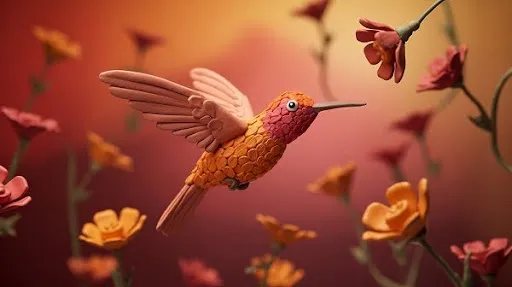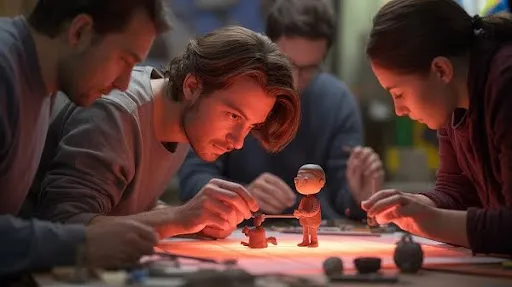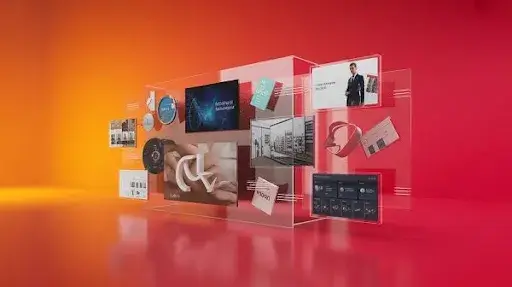Stop-motion has a scrappy kind of magic that glossy CGI can’t touch. It’s the charm of mistakes left in, the jitter in a mug sliding across the counter, or the awkward way LEGO figures swing their arms during a fight.
A clay creature limping toward the camera feels alive in a way a render never could. It’s like you’ve stumbled into a secret set where objects sneak off to play once no one’s looking.
If you’re itching to try it yourself, here are some stop motion ideas worth exploring. Some projects can be finished in an afternoon with whatever’s lying around the house. Others call for patience and plenty of clicks on that camera button, but the payoff is always worth the sore fingers. Pick a theme, set up your frame, and let the stop-motion sequence take shape.
-
Dancing Food
Food is a natural performer. It’s colorful, recognizable, and oddly funny when it starts moving around on its own. Picture a burger that assembles itself, bun by bun, or grapes bouncing in sync like they’re keeping rhythm. These quick clips make perfect creative stop-motion content for social feeds.
Keep the background simple so the colors stand out, use bold tones so food doesn’t fade on camera, and lock your setup firmly in place. Once filming wraps, the cast doubles as lunch.
-
LEGO Stop-Motion
LEGO owns a special place in stop-motion culture. The bricks are built for storytelling, castles, space ships, or whole cities pieced together. Minifigs may be stiff, but their little gestures carry charm, which is why LEGO often tops the list of popular stop-motion ideas.
Start small with a short clip of a knight charging at a dragon. Play with lighting: dim setups can make things dramatic, while bright light keeps the tone playful. Mix themes or sets for a mashup vibe that’s always fun to watch.
-
Claymation
Clay is messy in the best possible way. Roll it, squash it, and stretch it into a crooked smile; suddenly, you’ve got a character with personality. It’s the foundation of many successful stop-motion movies like Chicken Run or The Nightmare Before Christmas.
Keep clay soft so it bends without cracking. Stick to a consistent backdrop to avoid clutter. Don’t chase perfect lines; those imperfections are what make claymation stand out among other intricate stop-motion ideas.
-
Paper Puppets
Paper is as budget-friendly as it gets, yet it unlocks endless ideas for stop-motion. Grab some stiff card, scissors, and a couple of split pins, and you’ve got characters in minutes.
Use heavier paper so limbs don’t flop. Small props like hats or swords add personality. Subtle movements work best since big motions look jerky. Paper puppet clips are a favorite for school projects, but they also fit right in as quirky stop-motion video content for the web.
-
Coins and Everyday Objects
You don’t need elaborate sets. A handful of coins, a pen, or keys can carry a whole stop-motion sequence. Imagine coins spelling out words or pencils rolling themselves into a spiral. It’s simple, quick, and engaging.
Keep the camera overhead for alignment. Sticky tack keeps things steady. Play with light and shadows for extra depth. These short clips are quick to produce and count among the easiest ideas for stop-motion beginners.
-
Miniature Toy Parade
Toys have built-in character. Line up dinosaurs, action figures, or cars, toss in a balloon, and you’ve got yourself a parade. Nostalgia plays a huge role in why toy-based projects are such popular stop-motion ideas.
Plan the order so you don’t get lost mid-shoot. Fix the camera in place. Add sound effects for a boost in comedy. Precision isn’t required; the slight chaos adds to the fun.
-
Magical Book Pages
Books transform into captivating props once animated. Pages turning on their own, doodles coming to life, or letters dancing across lines, each frame builds into something enchanting.
Use sticky strips to keep pages steady. Strong light stops shadows from stealing focus. Add handwritten notes or sketches for flair. These projects take longer but can become advanced stop-motion ideas with serious wow factor.
-
Cupboard Adventures
Your kitchen doubles as a ready-made stage. Plates, mugs, and cutlery can all take part. Forks can duel, cups can chat, and plates can shuffle like dancers.
Tape fragile pieces so they don’t topple. Maintain consistent lighting for believability. Smaller moves often look smoother than dramatic jumps. This kind of stop-motion animation doesn’t even require buying props; the cupboard has everything you need.
-
Domino Tricks
Dominoes are already satisfying, but stop-motion pushes them further. Instead of one clean topple, animate them to form shapes, spell words, or pull off impossible tricks.
Draw the design before you start. Use a remote shutter so you don’t bump anything. Quiet spaces work best to avoid accidents. Simple as it sounds, domino-based stop-motion videos rarely fail to impress.
-
Nature Scenes
Step outdoors, and the props are endless. Stones stack into towers, leaves drift into patterns, petals scatter into shapes. Nature offers textures and palettes that stand apart from studio props.
Golden hour light makes everything glow. Lightweight objects may need sticky putty. Watch for moving shadows. Outdoor work is unpredictable, but that unpredictability can turn into the highlight of your stop-motion sequence.
-
Walking Shoes
Shoes are natural storytellers. Sneakers can strut, boots can hop, laces can knot themselves mid-frame. With a few tweaks, shoes become characters in your stop-motion video.
Fishing line helps with jumps. Smaller movements read as more realistic. Keep backgrounds minimal so the focus stays on the shoes. Plenty of brands use this trick for campaigns, but it’s just as fun for personal experiments.
-
Chalkboard Stories
Drawings make for standout creative stop-motion content. A chalkboard or even a sidewalk sketch can grow into a whole clip. A stick figure climbing stairs or a cat chasing a mouse, it’s all possible.
Thick strokes show best on camera. Wipe carefully to avoid smudges. Keep your tripod locked in place. This technique relies more on drawing skill than props, making it a fresh spin on traditional stop motion ideas.
Advanced Stop-Motion
Once you’ve got the basics, push further. Create layered paper sets, build LEGO cities with story arcs, or design multi-character claymation scenes. You can even merge footage with visuals from a 3D animation studio for something unique.
These projects are slower to finish, but they highlight how far stop-motion animation can go. They’re not just for fun; they’re often the foundation of standout campaigns or short films.
Stop-Motion in Everyday Life
The charm of stop-motion is that you don’t need much to begin. No studio lights. No professional rig. The desk you’re at or the kitchen counter is enough. A toothbrush inching toward the sink, socks sneaking across the carpet, or a coffee mug spinning as if late for work, everyday stuff suddenly feels alive.
That’s what makes it fun. Turning the ordinary into something a little weird, a little magical. People connect because it’s both familiar and unexpected. A short stop-motion sequence made with nothing fancy doesn’t just amuse, it usually earns a grin.
And when it comes to reach? Platforms like TikTok, Reels, or Shorts thrive on playful bursts of creative stop-motion content. It slides right in, feeding the endless scroll with moments that stick.
Stop-Motion for Storytelling
Goofy clips are one thing, but when you wrap a story around them, stop-motion becomes something else entirely. Think of Wallace & Gromit’s slapstick messes or the layered beauty of Kubo and the Two Strings. Both show how much soul a frame-by-frame world can hold.
You don’t need a feature film. A single minute is plenty. A toy soldier crossing a sofa battlefield, a paper cutout following a doodled map, or clay figures sharing a bite, tiny worlds, big heart.
Sound helps too. A squeaky step, a clap of thunder, or a quick line of dialogue, suddenly the trick feels like a stop-motion video instead of just a clever loop.
Stop-Motion in Marketing and Ads
Brands have noticed. Stop-motion breaks the pattern of sleek, polished ads. A cereal box pouring itself, sneakers walking in without a foot, or skincare bottles scooting into place, it’s scrappy and playful but still sells.
And the kicker? It’s affordable. A phone, a tripod, and patience can outshine an expensive shoot. That’s why indie brands and small businesses lean on popular stop-motion ideas: handmade beats over-produced in crowded feeds.
Tips for Cleaner Stop-Motion
Want smoother clips? A few quick habits make all the difference:
- Lock the camera down; even a small shake ruins flow.
- Rough storyboard it first so you don’t stall mid-shoot.
- Keep lighting steady; natural light flickers too easily.
- Be patient, ten seconds polished can take hours.
- Move in baby steps; big leaps look clunky.
No matter if you film a stop-motion video with LEGO, paper props, or clay, these basics keep your animation looking sharp.
Stop-Motion and Social Feeds
Scroll long enough and you’ll spot it, cookies “baking” themselves, shirts folding alone, pencils lining up neatly. Stop-motion thrives on social because it interrupts the monotony. It makes people pause.
Each app leans its way: TikTok is fast and funny, Instagram leans polished, and YouTube Shorts lives in between. But across all of them, creative stop-motion content usually outperforms static photos. Movement wins attention.
The Learning Curve
The first few tries? Always clunky. That’s part of the appeal. Even big studios let little jitters slip through.
Start small: coins shuffling into a row, clay blobs morphing, paper shapes sliding around. Once you’re confident, stack on characters, props, and sets to create more intricate stop-motion ideas.
Some creators obsess over silky-smooth animation. Others let it stay jerky and raw. Both work. That’s the beauty of stop-motion animation, no single formula.
Playing With Styles
As skills grow, experimentation comes naturally. Mix chalk sketches with clay, combine stop-motion with 3D, or drag in nature, stones, sand, leaves, to change texture.
The more you mess around, the faster you stumble into advanced stop-motion ideas that feel uniquely yours. That’s when it gets exciting.
Frequently Asked Questions
Is stop-motion hard?
Not really. It’s more patience than skill: move, snap, repeat. Kids pick it up easily.
What gear do I need?
A phone and a tripod are fine. Add lighting for consistency. Plenty of free or cheap apps help film a stop-motion video.
How many frames per second is optimal?
12 is a good start. Studios push for 24, but beginners often stick with less.
Is stop-motion useful for business?
Absolutely. It grabs attention, feels handmade, and doesn’t burn the budget. Many small brands now rely on creative stop-motion content in campaigns.
What are some of the starter ideas?
Stack fruit, walk LEGO minifigs, or spell words with coins. Simple but effective stop motion ideas always work.
How much time does it take to film stop-motion?
A few hours for a short clip. Days for something more complex or advanced stop-motion ideas.
What are the best software for stop-motion?
Free or low-cost apps like iMotion or Stop Motion Studio get the job done. For professionals, a 3D animation studio might blend stop-motion with CGI.
Final Words
Stop-motion moves at its own pace, slow, deliberate, almost stubborn. But that’s also why it stands out. Each frame is a choice. Each movement, intentional. CGI can’t quite replicate that handmade rhythm.
For beginners, it might just be a cookie sliding across the counter or a sketch wiggling to life. For pros, it becomes claymation shorts or marketing campaigns with millions of views.
Either way, stop-motion proves you don’t need deep pockets or advanced tools. What you do need is time, curiosity, and the nerve to make still objects dance. If you’re looking for inspiration, start with these stop motion ideas, and you’ll be surprised how quickly your project finds its own spark.
Get in touch with Prolific Studio today, one of the best animation studios in Chicago, and have the best stop-motion services for your brand.
Related Articles:
- Motion Graphics Explained
- Everything You Need to Know About Tweening in Animation
- Tweening vs Morphing: Key Differences










